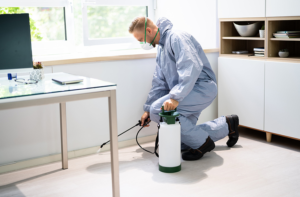Pest control is essential for keeping your home and yard healthy. Whether it’s ants, rodents, or cockroaches, getting rid of unwanted guests is essential for your health and safety.
Pest control has three main goals: prevention, suppression, and eradication. Prevention involves preventing pests from causing harm, suppression reduces pest numbers to an acceptable level, and eradication destroys the pest population. Contact Seaside Pest Control now!

Pests are more than just a nuisance; they can contaminate food, cause asthma or allergies, damage clothing and furniture, and even start fires by chewing through wire. A little preventative care goes a long way in keeping pests at bay.
Prevention begins with removing the attractants that lure the pests to their homes or businesses. Store food in airtight containers like Tupperware or jars, and cover trash cans tightly. Regularly wipe down counters and floors to eliminate spilled food, crumbs, and other attractive materials.
Outside the home, keep woodpiles away from foundation walls and regularly clean gutters and debris piles. Trim grass and prune shrubs and trees to prevent their overgrowth into places where rodents can hide. Use caulking or other bug-proof materials to seal holes in the home’s walls, roof, and utility lines.
Biological Pest Control
This involves using organisms that naturally prey or parasitize the pests, such as predators, parasitoids, or disease pathogens. Some biological methods involve introducing the organisms in a controlled manner, such as when nematodes are introduced to control plant mites in orange groves. Classical biological controls include releasing natural enemies in the fields to reduce the level of pests below economic damage levels.
Other methods can be used to help reduce the risk of an infestation, such as putting out baits or traps to kill the pests when they’re small and before they become a problem. These baits and traps typically contain pheromones, carbon dioxide, odor or other substances that trigger the pests’ death or deter them from coming back.
Another important step is monitoring for signs of pests and promptly treating problems when they occur. In many cases, this can stop the problem before it becomes a serious issue.
In addition, employees at food plants should be encouraged to take precautions against carrying pests into the workplace on their clothing and belongings. This can prevent an entire line of production from being impacted by a single infestation of cockroaches, for example. By educating staff and providing training on what to watch out for, this risk can be reduced.
Suppression
When a pest population has grown beyond an acceptable level, suppression methods are used to reduce its numbers. The goal is to control the pest to a level where the damage it causes is no longer economically unacceptable. This requires an understanding of the life cycle and ecology of the pest, as well as a careful assessment of the costs and benefits of controlling it.
Suppression methods limit the number of insects, weeds, viruses, bacteria or vertebrate animals by eliminating or restricting their reproduction or dispersal. They can be preventive or curative. Preventive controls, such as regularly cleaning areas where pests are likely to live or quickly applying control measures when their populations are low, help avoid infestations. Curative controls, such as the use of chemicals or changes in cultural practices, reduce the environment that favors pest growth.
Pests are undesirable organisms that interfere with human activities, degrade the quality of agricultural crops and natural resources, or displace native plants and wildlife species. They can also alter environmental factors such as soil health, nutrient content and availability, fire regimes, and the amount of available moisture.
The biological control of pests utilizes predators, parasites, and pathogens to reduce pest numbers. The nematode Steinernema carpocapsae, for example, is an effective parasitic pest control. It is sprayed on the soil, where it kills fleas, grubs and other insects by injecting them with a toxic bacterium that invades their bodies and kills them from within.
Chemical control of pests uses products that are designed to kill or suppress the pests, while minimizing harm to non-target organisms. This typically involves a combination of methods such as cultural controls, limiting pesticide applications to areas of high pest density, and spraying alternating strips of a field. It also involves using less persistent pesticides, which reduce the likelihood that natural enemies will be exposed to the pesticide and become susceptible to it.
Mechanical and physical controls are devices, traps, screens, fences and barriers that kill the pests or make their environment unsuitable for them. They may include traps for rodents, mowing or hoeing weeds, steam sterilization of the soil for disease management, or barriers to keep birds and insects out. All pest control methods require personal safety, including reading product labels and wearing proper protective equipment (PPE).
Eradication
Eradication is the removal of a pest to the extent that it can no longer cause damage or disease. This requires intensive control measures that may include disease vaccination, quarantine, eradication programs, and other techniques (Breman and Arita 1980). In this stage of pest control, the focus is on eliminating the source of infection and stopping transmission to new populations.
In some cases, the intensity of eradication programs has led to the decline or even extinction of native invertebrate species that share habitat with a targeted pest. For example, a combination of intense eradication efforts and overall anthropogenic landscape changes caused the extinction of the Rocky Mountain grasshopper (Melanoplus spretus). Achieving eradication may require the involvement of several international agencies and organizations.
Chemical pesticides are among the most common tools used in eradication, and they can be applied to both the target organism and its environment. These substances kill or inhibit the growth of insects, weeds, and other unwanted plants, but they also pose significant health risks to humans. Many people suffer from allergic reactions to these substances, and some are severely or fatally ill.
Another approach to eradication is to use natural enemies of a pest, such as parasites, predators, or pathogens, to control it. This approach can be effective and is less costly than a traditional insecticide application. However, the degree of control often fluctuates, and there is a time lag between the introduction of a biological enemy and its impact on a pest population.
Some eradication programs are based on the use of parasitic nematodes, microscopic worms that live in soil. These worms are helpful in controlling fleas, grubs, and other insects that damage gardens. Nematodes can be sprayed in large quantities to quickly cover a wide area. Some of these nematodes, such as the cockroach-eating nematode Steinernema carpocapsae, are sold commercially.
Economic evaluations of eradication programs are complex and difficult to determine. One method consists of projecting future infection and vaccination costs, attaching values to these, and discounting them to produce an “eradication dividend.” This amount should then be compared with the cost of implementing the eradication program.
IPM
Integrated Pest Management (IPM) is a long-term approach to managing pests in cropland and gardens by combining biological, cultural, physical and chemical tools and strategies. Its aim is to control and minimize pests without harming people, property or the environment.
A plant’s defenses can be overwhelmed by a variety of invaders, from rodents and nematodes to insects, birds, fungi and disease organisms. Affected plants can become unsightly and unproductive. IPM programs work to prevent these pests from becoming a problem by selecting the right plants for the site, planting them in the right way, and ensuring that they receive adequate water and nutrients.
When prevention fails, IPM includes a wide range of controls, starting with less toxic alternatives to strong treatment chemicals. When necessary, these include cultural, mechanical and biological measures such as:
Monitoring and scouting are key to an IPM program. Inspect and observe landscapes, crops, or indoor areas to determine the presence of pests and their level of damage. Accurately identify the pest and its host plant. Establishing action thresholds, which dictate the size, scope, and intensity of an IPM program, is important. This is especially important when dealing with children’s environments, where pesticides can pose a serious health hazard.
Pests often have many sources of food, water, and shelter in a landscape or building, so control techniques are designed to eliminate or reduce these resources. Eliminating their access to one or more of these is likely to dramatically reduce the number and severity of pests.
When an IPM program is implemented, it can save money in the long run by reducing the need for costly repairs and other problems that result from uncontrolled pest infestations. The program can also help minimize the need for pesticides in schools, where children spend a significant portion of their time. It can improve the learning environment by reducing health hazards associated with rodent and insect infestations, asthma triggers from cockroaches and other pests, and exposure to over-applied or misused pesticides. It can also provide a safe, clean space for children to play and learn.




